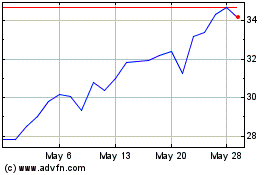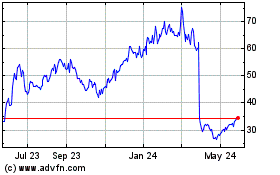Disc Medicine, Inc. (NASDAQ:IRON), a clinical-stage
biopharmaceutical company focused on the discovery, development,
and commercialization of novel treatments for patients suffering
from serious hematologic diseases, today presented topline data
from AURORA, a phase 2 study of bitopertin in patients with EPP.
Treatment with bitopertin resulted in statistically significant
reductions in PPIX, the primary endpoint, and significant
improvements in the rate of phototoxic reactions with pain and the
Patient Global Impression of Change (PGIC). On the key secondary
endpoint of cumulative time in sunlight on days without pain,
bitopertin patients had a positive response consistent with BEACON
results, but the endpoint did not meet statistical significance due
to strong placebo performance.
“This study has confirmed that bitopertin significantly reduces
the toxic metabolite, PPIX, in patients with EPP, and we have shown
that bitopertin-treated patients experience improvements in the
clinically meaningful outcomes of Patient Global Impression of
Change and the number and rate of phototoxic reactions with pain,
with the 60 mg dose reaching statistical significance compared to
placebo. Despite the strong performance of bitopertin on the key
secondary endpoint of cumulative time in light, consistent with
results seen in BEACON, statistical significance was not met due to
an outsized placebo response,” said John Quisel, J.D., Ph.D.,
President and Chief Executive Officer. “Given that, we will need to
conduct an analysis of our final data set and work with
investigators, regulators, and patient advocacy groups to define
the optimal registrational endpoints moving forward. While we do
this additional work, we continue to be excited about the upcoming
readouts from our other programs, including updated data from our
DISC-0974 study in anemia of myelofibrosis in Q2.”
The AURORA study is a randomized, double-blind,
placebo-controlled phase 2 study that enrolled 75 adult subjects
with EPP. Subjects were randomized 1:1:1 to receive 20 mg of
bitopertin, 60 mg of bitopertin, or placebo once daily for 17
weeks.
Summary of topline results
Primary endpoint
- Bitopertin resulted in significant,
dose-dependent, and sustained reductions in whole blood PPIX
levels: -21.6% for 20 mg (p=0.003 vs placebo) and -40.7% for 60 mg
(p<0.001 vs placebo); the placebo group had mean increases of
+8.0%
Secondary endpoints
- Cumulative total time in sunlight
between 10 am and 6 pm on days without pain observed over the
4-month treatment period: bitopertin-treated patients recorded a
mean of 175.1 hours at 20 mg and 153.1 hours at 60 mg, compared
with 133.9 hours for placebo; results were not statistically
significant compared to placebo
- The magnitude of the improvement in
the bitopertin-treated patients was comparable to that observed in
the BEACON study, but the benefit in the placebo arm in the AURORA
trial was greater than expected
- Large improvements in light
tolerance from baseline in 20 mg and 60 mg bitopertin treatment
groups as measured by time to prodrome; results were not
statistically significant relative to placebo.
- Substantial and dose-dependent
reductions in phototoxic reactions with pain during the 4-month
study period:
- 75% reduction in the incidence rate
of new phototoxic reactions with pain at the 60 mg dose group
compared to placebo (p=0.011); 60% reduction in the 20 mg dose
group (p=0.109)
- Fewer bitopertin-treated patients
reported a phototoxic event compared to placebo: 19% for 20 mg and
12% for 60 mg compared to 46% for placebo
- Dose-dependent improvements in PGIC,
which were statistically significant for the 60 mg dose: 77% of
completers at 20 mg and 86% at 60 mg (p=0.022 vs placebo) reported
that their EPP was “much better” compared with 50% for placebo
- Bitopertin was generally well
tolerated in both dose groups with no serious adverse events and
stable hemoglobin levels. Two patients discontinued treatment due
to treatment-emergent AEs, both in the 60 mg dose group: one due to
dizziness and one due to a skin rash. The most common AE reported
with bitopertin treatment was dizziness: n=4 in the 20 mg dose
group, n=11 in the 60 mg dose group compared with n=4 in the
placebo group (median durations of 4.5, 5, and 2 days,
respectively)
Webcast Conference Call InformationManagement
will host a call on Monday, April 1 at 8:30 am ET to review the
data. Please register for management’s webcast on the Events and
Presentations page of Disc’s website
(https://ir.discmedicine.com/).
About BitopertinBitopertin is an
investigational, clinical-stage, orally-administered inhibitor of
glycine transporter 1 (GlyT1) that is designed to modulate heme
biosynthesis. GlyT1 is a membrane transporter expressed on
developing red blood cells and is required to supply sufficient
glycine for heme biosynthesis and support erythropoiesis. Disc is
planning to develop bitopertin as a potential treatment for a range
of hematologic diseases including erythropoietic porphyrias, where
it has potential to be the first disease-modifying therapy. There
are currently two ongoing phase 2 clinical trials of bitopertin in
patients with EPP that have fully enrolled and have had key data
readouts: the open-label trial called BEACON and a randomized,
double-blind placebo-controlled trial called AURORA.
Bitopertin is an investigational agent and is not approved for
use as a therapy in any jurisdiction worldwide. Disc obtained
global rights to bitopertin under a license agreement from Roche in
May 2021.
About Erythropoietic Protoporphyria (EPP) and X-linked
Protoporphyria (XLP)Erythropoietic protoporphyria (EPP)
and X-linked Protoporphyria (XLP) are rare, debilitating and
potentially life-threatening diseases caused by mutations that
affect heme biosynthesis, resulting in the accumulation of a toxic,
photoactive intermediate called protoporphyrin IX (PPIX). This
causes severe reactions when patients are exposed to sunlight,
characterized by excruciating pain, edema, burning sensations and
potential blistering and disfigurement. PPIX also accumulates in
the hepatobiliary system and can result in complications including
gallstones, cholestasis, and liver damage in 20-30% of patients and
in extreme cases liver failure. Current standard of care involves
extreme measures to avoid sunlight, including restricting outdoor
activities to nighttime, use of protective clothing and opaque
shields, and pain management. This has a significant impact on the
psychosocial development, quality of life, and daily activities of
patients, particularly in young children and families. There is
currently no cure for EPP and only one FDA-approved therapy, a
surgically implanted synthetic hormone designed to stimulate
melanin production called Scenesse® (afamelanotide).
About Disc MedicineDisc Medicine is a
clinical-stage biopharmaceutical company committed to discovering,
developing, and commercializing novel treatments for patients who
suffer from serious hematologic diseases. We are building a
portfolio of innovative, potentially first-in-class therapeutic
candidates that aim to address a wide spectrum of hematologic
diseases by targeting fundamental biological pathways of red blood
cell biology, specifically heme biosynthesis and iron homeostasis.
For more information, please visit www.discmedicine.com.
Disc Medicine Cautionary Statement Regarding
Forward-Looking Statements
This press release contains “forward-looking statements” within
the meaning of the Private Securities Litigation Reform Act of
1995, including, but not limited to, express or implied statements
regarding Disc’s expectations with respect to its BEACON Phase 2
clinical studies of bitopertin and projected timelines for the
initiation and completion of its clinical trials and other
activities. The use of words such as, but not limited to,
“believe,” “expect,” “estimate,” “project,” “intend,” “future,”
“potential,” “continue,” “may,” “might,” “plan,” “will,” “should,”
“seek,” “anticipate,” or “could” or the negative of these terms and
other similar words or expressions that are intended to identify
forward-looking statements. Forward-looking statements are neither
historical facts nor assurances of future performance. Instead,
they are based on Disc’s current beliefs, expectations and
assumptions regarding the future of Disc’s business, future plans
and strategies, clinical results and other future conditions. New
risks and uncertainties may emerge from time to time, and it is not
possible to predict all risks and uncertainties. No representations
or warranties (expressed or implied) are made about the accuracy of
any such forward-looking statements.
Disc may not actually achieve the plans, intentions or
expectations disclosed in these forward-looking statements, and
investors should not place undue reliance on these forward-looking
statements. Actual results or events could differ materially from
the plans, intentions and expectations disclosed in the
forward-looking statements as a result of a number of material
risks and uncertainties including but not limited to: the adequacy
of Disc’s capital to support its future operations and its ability
to successfully initiate and complete clinical trials; the nature,
strategy and focus of Disc; the difficulty in predicting the time
and cost of development of Disc’s product candidates; Disc’s plans
to research, develop and commercialize its current and future
product candidates; the timing of initiation of Disc’s planned
preclinical studies and clinical trials; the timing of the
availability of data from Disc’s clinical trials; Disc’s ability to
identify additional product candidates with significant commercial
potential and to expand its pipeline in hematological diseases; the
timing and anticipated results of Disc’s preclinical studies and
clinical trials and the risk that the results of Disc’s preclinical
studies and clinical trials may not be predictive of future results
in connection with future studies or clinical trials and may not
support further development and marketing approval; the other risks
and uncertainties described in the “Risk Factors” section of our
Annual Report on Form 10-K for the year ended December 31, 2023 and
other documents filed by Disc from time to time with the Securities
and Exchange Commission (SEC), as well as discussions of potential
risks, uncertainties, and other important factors in Disc’s
subsequent filings with the SEC. Any forward-looking statement
speaks only as of the date on which it was made. None of Disc, nor
its affiliates, advisors or representatives, undertake any
obligation to publicly update or revise any forward-looking
statement, whether as result of new information, future events or
otherwise, except as required by law.
Media Contact
Peg RusconiVerge Scientific
Communicationsprusconi@vergescientific.com
Investor Relations Contact
Christina TartagliaStern Investor
Relationschristina.tartaglia@sternir.com
Disc Medicine (NASDAQ:IRON)
Historical Stock Chart
From Jan 2025 to Feb 2025

Disc Medicine (NASDAQ:IRON)
Historical Stock Chart
From Feb 2024 to Feb 2025
